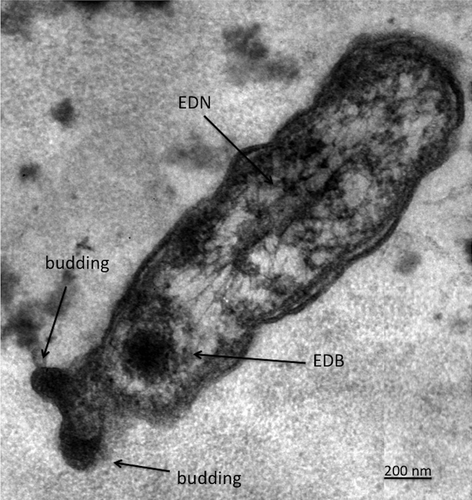Abstract
Experiments where the amino acid deficient strain E.coli AB1157 was exposed to a particle fraction harvested from a marine oligotrophic environment, ranging in diameter size between 100-130 nm indicated evidence for horizontal gene transfer resulting in revertant cells with restoration of all genetic deficiencies with frequencies up to 1.94 x 10-5. None of the markers was preferentially transferred indicating that the DNA-transfer is performed by generalized transduction. The highest transfer frequency obtained for single markers was 1.04 x 10-2. All revertant strains were able to produce particles of comparable size that were again infectious, appearing at the beginning of the stationary phase. Ultra structural investigation showed a structural resemblance with membrane vesicles, however, Field Gel Electrophoresis indicated that the DNA content of some of the particles was 370 kbp; much higher than that of the so far known previously described membrane vesicles providing evidence of a new mechanism for horizontal gene transfer.
Prokaryotes are known to be unique in their ability to react to environmental changes by the rapid acquisition of the necessary and appropriate genetic traits. This genetic flexibility of the prokaryotes is mainly due to the natural existence of seemingly efficient means for horizontal gene transfer among bacteria as well as between bacteria and other organisms.Citation1 Genetic exchange, therefore, plays a key role in the evolution of prokaryotes and the mechanisms responsible for the horizontal DNA transfer include (1) the Austriauptake of free DNA from the environment, transformation, (2) the transfer of DNA from a bacterial donor cell to a bacterial recipient cell termed conjugation, (3) the phage-mediated passage of bacterial genes referred to as transduction, (4) the gene transfer agents (GTA), an unusual bacteriophage-like vehicle of genetic exchange. We want to draw attention to a fifth mechanism, the transfer of DNA packaged in membrane vesicles which are formed by Gram negative bacteria.Citation2–Citation8 Because spontaneous formation of membrane vesicle-like particles by bacteria in the stationary was observed in earlier studies, we sampled the particle size class <0.2 µm from the Mediterranean Sea, separated the 100–130 nm size fraction by CsCl-density equilibrium ultracentrifugation and performed gene transfer experiments with an auxotrophic mutant strain E. coli AB1157. Growth studies of revertant cells, ultrastructural characterization and DNA-antibody labeling of TEM thin sections completed the gene transfer assays. Remarkably high gene transfer frequencies up to 10−2 were obtained for single markers.
One of the most surprising features of this study is that the results of this gene transfer are revertant cells, which are able to produce new particles which are released by budding (). These particles produced by the first cell generation (F1) are again infectious and possess also the capability to transfer genes. The resulting second cell generation (F2) was observed to manifest again particle production. These particles had a mean diameter and mode similar to those produced by the F1 cells, were again infectious and induced the production of an F3 revertant population, a phenomenon we termed serial transduction. The investigated particles show analogy to classical membrane vesicles but transfer contain large amounts of DNA up to 370 kbp to the recipient cells and are larger than so far known viruses, GTA particles or membrane vesicles. Recent genome analyses of membrane vesicles derived from two different Alpha-Proteobacteria revealed the predominance of bacterial sequences.
Addendum to:
References
- Lengeler JW, Drews G, Schlegel HG. Biology of the prokaryotes. Thieme Verlag 1999; 55
- Chiura HX. Generalized gene transfer by virus-like particles from marine bacteria. Aquat Microb Ecol 1997; 13:74 - 85
- Chiura HX, Velimirov B, Kogure K. Bell CR, Brylinsky M, Johnson-Green P. Virus-like particles in microbial population control and horizontal gene transfer in aquatic environments. Halifax: Microbial Biosystems: New frontiers 2000;
- Chiura HX. Novel broad host-range gene transfer particles in nature. Microb Environ 2004; 19:249 - 264
- Chiura HX, Kogure K, Hagemann S, Ellinger A, Velimirov B. Evidence for particle induced gene transfer and serial transduction between bacteria. FEMS Microbiol Ecol 2011; In press http://dx.doi.org/10.1111/j1574-6941.2011.01077.x
- Kadurugamuwa JL, Beveridge TJ. Membrane vesicles derived from Pseudomonas aeruginosa and Shigella flexneri can be integrated into the surfaces of other Gram-negative bacteria. Microbiology 1999; 145:2051 - 2060
- Mashburn-Warren LM, Whiteley M. Special delivery: vesicle trafficking in prokaryotes. Mol Microbiol 2006; 61:839 - 846
- Renelli M, Matias V, Lo RY, Beveridge TJ. DNA-containing membrane vesicles of Pseudomonas aeruginosa PAO1 and their genetic transformation potential. Microbiology 2004; 150:2161 - 2169
